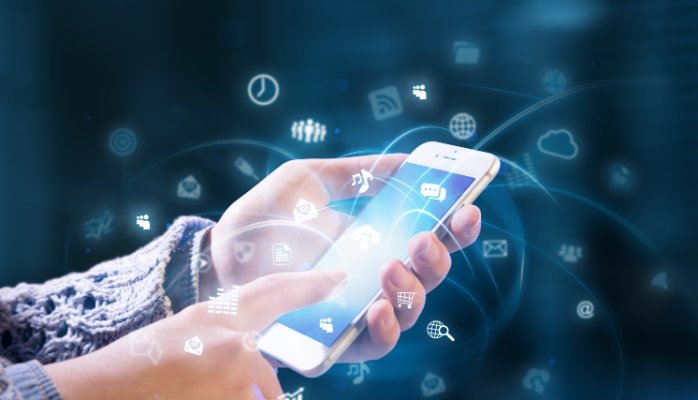Your smartphone lets you shop your favorite products when you are traveling through the subway and even when you are in bed. It opens the vast world of entertainment to you just in a flash and, it also lets you do many serious tasks, such as ordering a medicine which isn’t available at local pharmacies. You can order grocery using your smartphone and, you can also get home pick-up of your dirty clothes, as well as get them cleaned or dry-cleaned, ironed and delivered back to your home.
You can even time your blinds to automatically shutdown, in order to block morning sunlight that may awake you before you complete your sleep. A smartphone can also guide through ways into unknown and inform whether there are traffics in your area or not. You can also transfer important data and files to your peers and make money transactions in your accounts or on shopping sites.
Calling, texting, watching videos, listening to music, getting reminded about scheduled appointments & events are some fundamental uses of smartphones.
So smartphones are everywhere and, this is no secret anymore that our future belongs to smartphones. But what’s the future of apps on all smartphones utterly depend?
Here are five trends which will gradually become the core of every mobile app development in future.
Mobile centered IoT to get more purposes
IoT exits long before anybody thought of smartphones. Its foundation was laid down even before Kevin Ashton coined the term Internet of Things. But, there were several obstructions related to technology and, the key one of them was to not have easy wireless connectivity with devices. When smartphones were launched, they came with high-speed internet and several other types of connectivities like Bluetooth, Wi-Fi and infrared which companies and developers spotted ideal for IoT apps.
The hardware-support into devices has, of course, accelerated more IoT focused mobile app developments. This is why we will see the rise in the number of apps developed around the concept of IoT. As expected, almost 27 billion of home appliances and devices will be using IoT by 2020 and no doubt, these would be apps which let users connect and control these devices easily and without any limit of distance.
We already have mobile-IoT based lights, power sockets, cooling & heating systems, and various others home and office appliances.
M-Commerce to lead online selling and buying
We can notice an incredible rise in the shopping-searches through smartphone devices and, businesses, which are in retailing, know it. This is where m-commerce app development comes as one the most advanced technologies which allow retailers easily go online with their m-commerce apps.
However, m-commerce itself is nothing new but just the evolution of e-commerce. For now, both e-commerce and m-commerce seem to walk shoulder to shoulder and in some case, they harmonize each other. But with rising preference of customers for mobile devices, retailing businesses will focus more in m-commerce. In result, there will be more developments for m-commerce apps.
So do not think that m-commerce is overshadowing e-commerce. M-commerce is basically e-commerce only but on mobile devices, through mobile apps.
More mobiles apps using cloud technologies
Cloud computing is the most trending thing in IT industry. Things fueling it more and more are increasing storage requirements, ease of use, automatic software updates and users’ thirst for boundless access along with flexibility. Cloud computing has been exponentially growing at a rate of 4.5 times faster than the rate of IT spending since 2009. As per the experts of the field, the rate will exceed six times than the rate from 2015 to 2020.
Because cloud based apps are basically web apps using HTML5, CSS3 and, JavaScript and server-side languages such as C++ or Web application frameworks of the developer’s choice such as PHP, Rails and, Python in the core, they are quite affordable for all business sorts and sizes. When building these apps, the major cost investment goes into a single project which can be easily implemented in the cloud.
Also, cloud-apps operate through could sever which simply means these apps depend on browser engine of a device. These apps only use the browser or browser engine of a device to perform operations. With the support of framework specific APIs, cloud mobile apps can use almost all native device’s features like accelerometer, location, camera, etc.
In fact, all cloud apps are basically web apps which are either provided as mobile websites or into native wrappers. But not all web apps are cloud apps.
Wearable Devices
These days, wearable devices are considered as the most advanced medium to interact with technology. Apple’s watch and Google glass are some ultramodern examples. Application developers, for better communication, will develop new apps connecting a wide range of useful gadgets with smartphones.
Projecting wearable technology as the future of mobility isn’t hype at all. We generally mean wearable technology just by glasses, watches, and bracelets, but they are some consumer-products only.
The key feature making a gadget or device to be wearable is how easily it can be interacted, with little requirements of providing inputs. A true wearable gadget or device is one which can deliver results “with limited set of inputs operations”. Let us understand why it’s very important for the wearable devices to work with the limited set of inputs.
When devices become capable of performing operations with limited inputs, they become useful for a lot of purposes such as drivers or pilot at the wheel needs to perform a certain function on the device and they are capable of doing that without touching their mobiles. The disabled community will greatly benefit with wearable technology. There is a wearable jacket for those who are deaf so that that they can feel the music. There is a watch as the wearable gadget for blinds so that they can touch it to see to check time.
So there may be several uses of the wearable technology, but it will happen only if it becomes lighter and can be operated with the limited set of inputs.
Wearable devices are small and, they cannot have a full-featured platform like smartphones do. They will need connectivity with user’s device and, thus there will be the requirement of wearable mobile application developments.
Location & Motion Sensing
Almost all smartphones – either iPhones or Android phones – come with inbuilt location competency which can be used in apps for a variety of purposes. With the capability of sensing locations, apps can be developed for tasks like fitness tracking, vehicle navigation, geo-tagging, distance measuring, games and a lot more.
Then there is motion sensor which can be used in apps for anti-theft, games, power saving, and so on. There are other sensors like geomagnetic, ultrasonic, Wi-Fi and beacon-connectivity which we will see being used innovatively and intelligently in the future mobile app development projects.
Author Bio. :- Sofia Coppol is a digital marketing expert in Rapidsoft Technologies, a leading ERP Software Development Company which provides Software for Education, Automation, Construction and Finance across the global. She loves to write on latest mobile trends, mobile technologies, startups and enterprises.
























